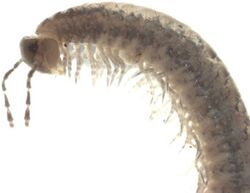Biology:Metopidiotrichidae
| Metopidiotrichidae | |
|---|---|

| |
| Schedotrigona | |
| Scientific classification | |
| Domain: | Eukaryota |
| Kingdom: | Animalia |
| Phylum: | Arthropoda |
| Subphylum: | Myriapoda |
| Class: | Diplopoda |
| Order: | Chordeumatida |
| Suborder: | Heterochordeumatidea |
| Superfamily: | Heterochordeumatoidea |
| Family: | Metopidiotrichidae |
Metopidiotrichidae is a family of millipedes in the order Chordeumatida. These millipedes range from 4 mm to 17 mm in length.[1] Adult millipedes in this family have 32 segments (counting the collum as the first segment and the telson as the last), not the 30 segments usually found in this order.[2][1] Adult males in this family (e.g., Reginaterreuma monroei, R. daviesae, R. unicolor, R. major, and Neocambrisoma raveni) often feature a reduced or vestigial leg pair 10 as part of the gonopod complex, in addition to the two leg pairs (pairs 8 and 9) typically modified into gonopods in this order.[3][4] There are about 9 genera and at least 70 described species in Metopidiotrichidae.[5][6][7]
Genera
These nine genera belong to the family Metopidiotrichidae:
- Australeuma Golovatch, 1986
- Malayothrix Verhoeff, 1929
- Metopidiothrix Attems, 1907
- Neocambrisoma Mauriès, 1987
- Nesiothrix Shear & Mesibov, 1997
- Nipponothrix Shear & Tanabe, 1994
- Pocockia Silvestri, 1895
- Reginaterreuma Mauriès, 1987
- Schedotrigona Silvestri, 1903
References
- ↑ 1.0 1.1 Enghoff, Henrik; Golovatch, Sergei; Short, Megan; Stoev, Pavel; Wesener, Thomas (2015-01-01). "Diplopoda — taxonomic overview" (in en). Treatise on Zoology - Anatomy, Taxonomy, Biology. The Myriapoda, Volume 2: 363–453. doi:10.1163/9789004188273_017. ISBN 9789004188273. https://brill.com/view/book/edcoll/9789004188273/B9789004188273_017.xml.
- ↑ Enghoff, Henrik; Dohle, Wolfgang; Blower, J. Gordon (1993). "Anamorphosis in Millipedes (Diplopoda) — The Present State of Knowledge with Some Developmental and Phylogenetic Considerations". Zoological Journal of the Linnean Society 109 (2): 103–234. doi:10.1111/j.1096-3642.1993.tb00305.x. https://academic.oup.com/zoolinnean/article-abstract/109/2/103/2646268?redirectedFrom=fulltext.
- ↑ Mauries, Jean-Paul (1987). "Craspedosomid Millipedes Discovered in Australia: Reginaterreuma, Neocambrisoma and Peterjohnsia, New Genera (Myriapoda: Diplopoda: Craspedosomida)". Memoirs of the Queensland Museum 25 (1): 107–133. https://www.biodiversitylibrary.org/page/40653793#page/109/mode/1up.
- ↑ Shear, William A. (2002). "The millipede genus Metopidiothrix Attems (Diplopoda : Chordeumatida : Metopidiotrichidae)" (in en). Invertebrate Systematics 16 (6): 849–892. doi:10.1071/IS02005. ISSN 1445-5226. https://www.researchgate.net/publication/248899901.
- ↑ "Metopidiotrichidae". https://www.gbif.org/species/8557.
- ↑ Shelley, R. M.. "The myriapods, the world's leggiest animals". University of Tennessee. https://ag.tennessee.edu/EPP/Pages/Nadiplochilo/Nadiplochilo.aspx.
- ↑ Sierwald, P.; Spelda, J. (2022). Millibase. doi:10.14284/370. http://www.millibase.org/. Retrieved 2020-10-26.
Further reading
- Brewer, M. S.; Sierwald, P.; Bond, J. E. (2012). "Millipede Taxonomy after 250 Years: Classification and Taxonomic Practices in a Mega-Diverse yet Understudied Arthropod Group". PLOS ONE 7 (5): e37240. doi:10.1371/journal.pone.0037240. PMID 22615951. Bibcode: 2012PLoSO...737240B.
- Golovatch, Sergei I.; Kime, R. Desmond (2009). "Millipede (Diplopoda) distributions: A review". Soil Organisms 81: 565–597. http://www.senckenberg.de/files/content/forschung/publikationen/soilorganisms/volume_81_3/24_golovatch.pdf.
Wikidata ☰ Q4282457 entry
 |

